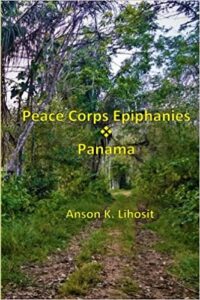
I’ve written my own Peace Corps memoir and reviewed many others of fellow RPCV writers, so when my author friend and fellow RPCV writer, Lawrence Lihosit mentioned that his son was also a Peace Corps Volunteer and had written a book about his experience, I offered to review his book.
Lawrence is a prolific writer and I just recently reviewed his latest book, Those Who Are Gone, which is about a time long past in my own community of Scottsdale, Arizona. I also used one of his 17 books, Peace Corps Experience: Write & Publish Your Memoir to write my first book, Different Latitudes.
According to his son Anson, he provided some sage advice before his son left for Panama, “Survive.” Evidently, Lawrence worked with his son on the book for three months, discussing the experience essays, making suggestions and formatting the book. Ultimately, Anson was grateful for his father giving him the idea that the Peace Corps would be a life-changing experience.
Anson would use his love of baseball to connect with the young people of his community in Panama. He opened his sports bag on the sideline of a Panama softball field and declared, “I want to play.” And he did, for two years (2015-2017), which were filled with cross-cultural misunderstandings and innumerable adventures.
Anson’s site was near the Darien Straits; on a scale of 1-10 (10 being the toughest), his community was a 2. He lived on a paved highway with intermittent water, electricity and indoor plumbing! Unfortunately, his experience was radically changed by a medical emergency. While returning to his place late one evening with a friend, his leg smashed into something and fell onto a car engine, which hadn’t been there earlier. Blood ran down the exposed pink muscle tissue on his shin and his friend confirmed, “Yeah, that is bone.”
This was bad enough, but it’s more complicated in the tropics because, as the Peace Corps Duty Officer explained, it could go septic. And it did, but he survived, although the recuperation process took three months. Anson referred to the brown scars of his wound his “tattoo”—a permanent reminder of this chapter in his Peace Corps experience.
Learning a new language is always one of the greatest challenges for a Peace Corps Volunteer, but I thought that Anson would have an advantage, since his mother is Mexican. (My only crutch was four years of Latin). But to my surprise, he was humbled in Spanish class. Even though he did practice Spanish at home, many of his classmates knew different tenses and had a larger vocabulary, so he was exhausted at the end of language class.
Often, what the local population in rural areas take for granted can be a difficult experience to a stranger from another country. So was the case of the killing of a goat. As part of his training, Anson participated in a lottery to kill a goat on four occasions. Finally his number came up and he had to make the deep cut in the goat’s neck, “The goat collapsed. Thick, bubbling blood ran. At the backyard sink, I washed the blood from my hands, feet and knife. The smell of goat and some of its hairs were stuck to my clothes. Another volunteer handed me a cup of hot black coffee and I lit a cigarette, watching the motionless body being strung up.”
Coming out to play softball rain or shine, (often in torrential rain), Anson opened doors with members of his community. On one occasion someone shouted, “Here comes the gringo!” ‘An old woman missing a few teeth sitting next to him smiled and waved to me…’
The author ends his book with those words that make any PCV’s spine tingle and eyes well up, “I am very happy to finish the first level English class. Speaking English is very good because it opens the door to new possibilities in our life. Thank you, God. Thank you, teacher. It’s never too late to learn.”
The book includes three maps, a number of ink sketches and a bibliography, as well as a “Fact Sheet,” which added to a better appreciation of Panama.
The Author
Anson grew up in Madera, California. He earned a bachelor’s degree in urban planning at Northern Arizona University in Flagstaff and worked as an urban planner before volunteering for the Peace Corps. He is currently a master’s candidate in urban planning at the University of Arizona in Tucson.
The Reviewer
Mark Walker was a Peace Corps Volunteer in Guatemala and spent over forty years helping disadvantaged people in the developing world. Walker’s three books are Different Latitudes: My Life in the Peace Corps and Beyond, My Saddest Pleasures: 50 Years on the Road, named Best Travel Book, and The Guatemala Reader: Extraordinary Lives and Amazing Stories. He’s written 80 book reviews, and of his 30 published essays, two were recognized by the Solas Awards for Best Travel Writing. He’s a contributing writer for “The Wanderlust Journal,” “Literary Traveler,” and “The Great Writers You Should be Reading.” His column, “The Million Mile Walker Review: What We’re Reading and Why,” is part of the Arizona Authors Association newsletter. His honors include the “Service Above Self” award from Rotary International. He’s a Board member of SEEDS for a Future, Advance Guatemala, and the Arizona Authors Association. His wife and three children were born in Guatemala. You can learn more at www.MillionMileWalker.com